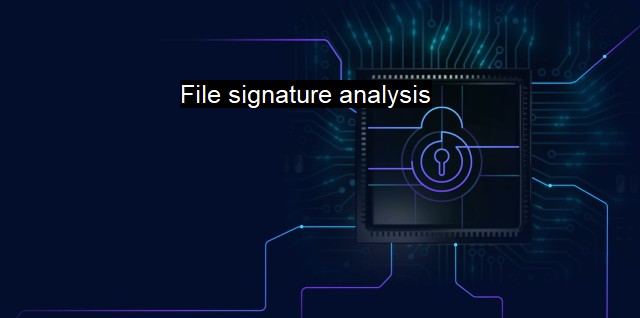What are File signature analysis?
The effectiveness of File Signature Analysis for Computer System Security in the Age of Advanced Threats
File Signature Analysis is a critical aspect of cybersecurity systems and antivirus software. This technique allows systems to identify safe or malicious code from an unknown file, helping avoid potential threats that could compromise important data or the entire network. it helps recognize different file formats, even if they were somehow corrupted, renamed, or had their extensions changed.When you open a file on your computer, your operating systems use the file signatures, also known as magic numbers, to determine the file type. These signatures are unique pieces of code that signify what kind of information is inside the file. For instance, all JPEG files start with the same series of code. This unique series is the file's signature, and it's what allows your computer to process the file correctly.
File signature analysis becomes even more critical. Viruses, malwares, and other forms of cyber threats often conceal themselves as harmless files to infiltrate systems. Cybersecurity tools like antivirus software use file signature analysis to cross-check file signatures against a database of known malicious signatures. If the file’s signature matches one in the database, the file is flagged as a potential threat and is dealt with accordingly.
To give a better understanding, imagine receiving an e-mail attachment. You aren't sure if it's safe to open or not, so you examine its file signature. This set of unique data helps the antivirus software identify the possible risks associated with the file within seconds. This authentication process compares signatures with known malicious signature databases. If anything unusual stands out, the file is labeled as a threat.
Incorporating file signature analysis into cybersecurity practices not only enhances security but also adds a reliable layer of defense against myriad threats. It improves the antivirus program's capability to detect advanced persistent threats (APTs). APTs are malicious codes that infiltrate network systems and stay undetected for extended periods, causing substantial damage.
From the cybersecurity point of view, file signature analysis is a reactive approach to cyber threats. The security community collects data on new viruses and cyber threats, creates rules explaining those threats, and shares them through virus databases. The downside is, unknown or zero-day threats can still slip through and infect the system. Hence, file signature analysis should be complemented with other strategies such as behavioral analysis, machine learning algorithms, and AI to create a broader, more holistic defense system.
File signature analysis is a crucial component of cybersecurity and antivirus programs. It provides fast and reliable identification of known threats, preserving the normal functioning of the system while protecting sensitive information. it's essential to understand that file signature analysis itself is not a silver bullet that can solve all cybersecurity concerns. Its usefulness becomes magnified when combined with a layered security strategy that involves additional techniques like heuristic detection or anomaly-based detection. These different tools form a comprehensive defense strategy to keep your systems safe, secure, and performing optimally. Altogether, file signature analysis exemplifies the concept of cybersecurity being as good as not merely the strength of individual mechanisms but the harmonious incorporation of various tools.

File signature analysis FAQs
What is file signature analysis in cybersecurity?
File signature analysis is a technique used by antivirus software and security professionals to identify and classify files based on their unique patterns or signatures.How does file signature analysis work?
File signature analysis works by comparing the digital signatures of files against a database of known malicious signatures. If a match is found, the file is flagged as potentially harmful or suspicious.Why is file signature analysis important in cybersecurity?
File signature analysis is important in cybersecurity because it helps to detect and prevent malware and other types of cyber threats. It enables security professionals to quickly identify and respond to potential threats, which can help to mitigate the risk of data breaches and other cyber attacks.What are some limitations of file signature analysis?
There are several limitations to file signature analysis, including the fact that it can only detect known threats. This means that new and previously unseen threats may go undetected. Additionally, some types of malware are designed to evade signature-based detection methods, which can make them difficult to detect using this technique alone.| | A | | | B | | | C | | | D | | | E | | | F | | | G | | | H | | | I | | | J | | | K | | | L | | | M | |
| | N | | | O | | | P | | | Q | | | R | | | S | | | T | | | U | | | V | | | W | | | X | | | Y | | | Z | |
| | 1 | | | 2 | | | 3 | | | 4 | | | 7 | | | 8 | | |||||||